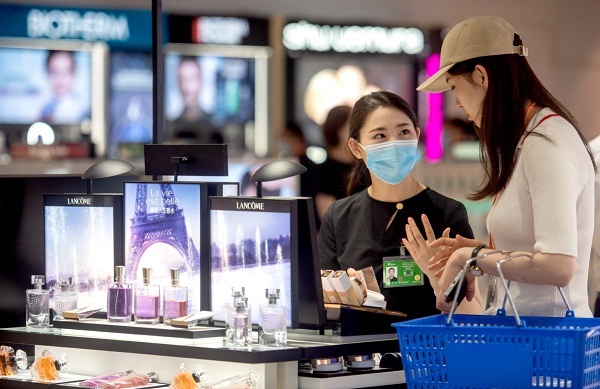
A tourist shops at a duty-free store in Hainan province. [Photo/chinadaily.com.cn]
Su Qingtian, a newlywed from East China's Fujian province, kicked off her honeymoon trip by spending big at the duty-free shops (DFS) in the southern Chinese island of Hainan.
"It's a fun day. I became a purchasing agent for family members and friends and even got a gold card membership," said Su, with over 10 bags in hand, sharing her experience on WeChat.
During the three-day New Year holiday, duty-free shops in Hainan launched a variety of promotions, drawing consumers from across the country.
Data from Haikou Customs show offshore duty-free sales in Hainan during the 2022 New Year holiday hit 600 million yuan ($94 million), up 9.7 percent year on year.
On New Year's Day alone, the island province's duty-free shops received 18,200 visits, with the per capita consumption hitting 8,917 yuan, up 9.9 percent and 17.3 percent respectively year on year. From Jan 1 to 3, about 739,000 items were purchased at these stores, an increase of 9.7 percent from a year ago.
Advantaged climate, good epidemic control measures and tempting discounts have together boosted DFS sales during the New Year holiday in Hainan, according to Wang Jiansheng, head of the Hainan Tourism Development Research Association.
Duty-free shopping has become one of the core competitive features of Hainan's tourism consumption. The province now boasts 10 duty-free shops, hosting more than 720 brands in a total shopping area of 220,000 square meters.
Since July 1, 2020, Hainan has raised its annual tax-free shopping quota from 30,000 yuan to 100,000 yuan per person. The duty-free purchase limit for cosmetics has been raised from 12 items to 30.
The province, which vows to build itself into a globally influential and high-level free trade port by the middle of the century, has also rolled out a range of policies such as flexible pick-up services to provide a better experience for customers.
In 2021, offshore duty-free sales in Hainan reached nearly 60.2 billion yuan, an increase of 84 percent year on year, said the provincial department of commerce.